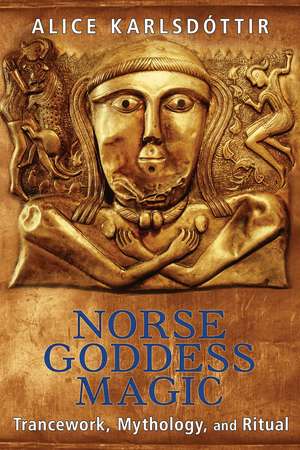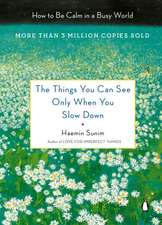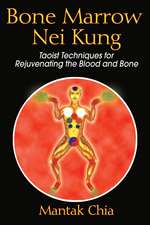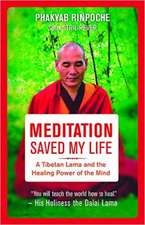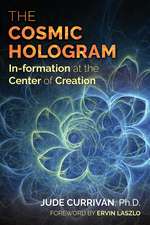Norse Goddess Magic: Trancework, Mythology, and Ritual
Autor Alice Karlsdóttiren Limba Engleză Paperback – 3 iun 2015
Detailing her trancework journeys to connect with the goddesses, the author reveals the long-lost personalities and powers of each deity. She explores the Norse goddess Frigg the Allmother, wife of Odin, along with the 12 Asynjur, or Aesir goddesses, associated with her, such as Sjofn the peacemaker, Eir the Healer, and Vor the Wisewoman. She shares their appearances in the Eddas and Germanic mythology and explains the meanings of their names, their relationships to each other, and their connections to the roles of women in Old Norse society. She provides detailed instructions for invocations and rituals to call each goddess forth for personal and group spirit work. She also offers a comprehensive guide to ritual tranceworking to allow anyone to directly experience deities and spiritual beings and develop spirit-work relationships with them.
Preț: 89.85 lei
Nou
Puncte Express: 135
Preț estimativ în valută:
17.19€ • 17.100$ • 14.31£
17.19€ • 17.100$ • 14.31£
Carte disponibilă
Livrare economică 10-24 martie
Livrare express 21-27 februarie pentru 26.80 lei
Preluare comenzi: 021 569.72.76
Specificații
ISBN-13: 9781620554074
ISBN-10: 1620554070
Pagini: 256
Ilustrații: 3 b&w illustrations
Dimensiuni: 152 x 229 x 15 mm
Greutate: 0.41 kg
Ediția:2nd Edition, New Edition of Magic of the Norse Goddesses
Editura: Inner Traditions/Bear & Company
Colecția Destiny Books
ISBN-10: 1620554070
Pagini: 256
Ilustrații: 3 b&w illustrations
Dimensiuni: 152 x 229 x 15 mm
Greutate: 0.41 kg
Ediția:2nd Edition, New Edition of Magic of the Norse Goddesses
Editura: Inner Traditions/Bear & Company
Colecția Destiny Books
Notă biografică
Alice Karlsdóttir has been involved in the Germanic Heathen revival for nearly 40 years, both as a student of Scandinavian and Northern European mythology and folklore and as a practicing Norse Pagan (Asatru). She is a Master in the Rune Gild, an initiatic organization for the teaching and research of runelore and runework, and has been a priestess in several kindreds. She has contributed articles to a number of publications, including Gnosis Magazine, as well as given workshops and presentations on runes, tranceworking, and ritual at various festivals. She lives in Houston, Texas.
Extras
Chapter 15
Sjofn
The Peacemaker
Lore
Sjofn is only mentioned in passing in the Eddas and skaldic lore. According to Snorri, the word sjafni (“love, affection”) was derived from her name. The Gylfaginning states that Sjofn is greatly concerned with turning people’s minds to love; the word used for “mind” is hugr, a broader term encompassing consciousness, intuition, emotion, and intellectual processes. Sjofn’s power affects a person at the deepest level of being, touching all facets of the soul. It is real frith, love and harmony that binds people together, the love of family, tribe, nation, and even of the world and life itself.
Frith is an Old Saxon word meaning “fruitful peace, joy”--a condition that automatically existed from birth between all members of a kin group and could be created between other people through such bonds as marriage, allegiance between a chieftain and his followers, and friendship. Kinfolk were united by mutual self-interest and self-sacrifice, bound in loyalty, peace, support, and joy. Frith unions other than blood kinship could only happen through the giving of gifts. In giving a gift, a person gave a part of the soul to the other, a physical manifestation of love and goodwill. Frith was the very core of the soul, the seat of a person’s humanity, the wellspring of all thoughts, feelings, and desires. This is the love Sjofn seeks to inspire.
Sjofn is connected to both sources of frith: kinship and gifts. She is involved in creating love where it did not exist before--marriage, new friendships, social and political alliances--and in restoring frith where it has been strained or broken.
Trance
I see her in the garden behind Frigg’s hall leaning on a tree. She seems rather plain for a love goddess. Her hair is an ordinary brown. Her voice is soft, light, and quick, and she has a subtle, worldly sense of humor. She puts her arm around me and leads me out of the garden.
We go to the home of a quarreling couple. She talks with both husband and wife, sitting them down at the table with her arm around them. She understands and empathizes equally with both. Afterward she goes outside to a meadow and sits beside a young girl. Sjofn talks to her of boys, now teasing and coy; she is suddenly more beautiful. Her hair is a tawny light brown with a hint of red, wavy and full. Her mouth is strong and sensual, her eyes gray-green and striking.
She next goes to a great hall and sits with leaders of nations and armies, trying to reconcile their differences, acting as diplomat. She is a chameleon, her appearance and manner changing from moment to moment. Her manner is warm and kindly, but uncompromising; she has empathy with old and young, men and women, rich and poor.
I see her on a rooftop during a festival. I sense the great love she feels for the crowd below, the stars, and the very air. Now she is in her late twenties. Her love is a love of gentleness, not lust. She is quiet, with deep humor and strong charisma.
Suddenly we are back in the garden, at the tree--an apple tree. She pulls off an apple, bites it, and laughs.
The few facts known about Sjofn and my impressions of her in trance point to broader aspects of love--the camaraderie and loyalty that hold societies together, the closeness and warmth that bind families, the joy that makes life worthwhile. Sjofn is a goddess for all, rich and poor, ugly and beautiful, foolish and wise. Adaptable, tolerant, and empathetic, she is able to deal with an infinite variety of situations.
Ritual
A ritual to Sjofn could be performed for any situation where harmony is desired--disruptive homes, bad work situations, meetings of kindreds with differing ideas, or even worldwide political conditions. Sjofn can also be called on to help select and bless gifts.
Muted shades--especially blues and greens--that promote harmony and calm might be used as altar decorations or clothing. An understated and subtle yet aesthetic altar is best for Sjofn. Try to reach a state of peace and contentment beforehand. Think of all the individuals, groups, places, activities, and things you love that make you glad to be alive. You could put some symbols of these on your altar. You might also want some people for whom you have particular affection to join you in this rite.
If you are doing the ritual to remedy some unpleasant condition or situation, take a few moments at some point during the ritual to clearly identify what the actual problems are and try to see what you can do to make things better. Visualize the situation as you want it to be, harmonious and friendly. Don’t expect Sjofn to turn things around if you don’t do your part. Similarly, don’t visualize the situation being remedied by gaining power over everyone else; Sjofn is not vengeful.
If others do the ritual with you, share some food and drink at the end. If you are alone, call or write loved ones afterward. Go do something celebratory where there will be lots of people.
Sjofn encompasses a world spirit, a reveling in the experience of being human. She is the specialness in everyday events, the joy of being in the present, the richness of contact with one’s fellows. She is both carnival and bedtime story, reveler and sister, joy and comfort, plenty and peace.
Call to Sjofn
Goddess of the gateway,
the open ear, the open heart, the open mind;
Goddess of the kind heart,
love-glad, joy-proud, life-strong;
Goddess of the wise heart,
bringer of frith, keeper of peace, mender of vows.
Goddess of the two sides, Goddess of the table,
Friend to men and women,
Goddess of love,
Goddess of the world--
Sjofn, we need you now.
Sjofn, Love Goddess,
Sjofn, we need you now.
Sjofn, Peacekeeper,
Sjofn, we need you now . . .
Sjofn
The Peacemaker
Lore
Sjofn is only mentioned in passing in the Eddas and skaldic lore. According to Snorri, the word sjafni (“love, affection”) was derived from her name. The Gylfaginning states that Sjofn is greatly concerned with turning people’s minds to love; the word used for “mind” is hugr, a broader term encompassing consciousness, intuition, emotion, and intellectual processes. Sjofn’s power affects a person at the deepest level of being, touching all facets of the soul. It is real frith, love and harmony that binds people together, the love of family, tribe, nation, and even of the world and life itself.
Frith is an Old Saxon word meaning “fruitful peace, joy”--a condition that automatically existed from birth between all members of a kin group and could be created between other people through such bonds as marriage, allegiance between a chieftain and his followers, and friendship. Kinfolk were united by mutual self-interest and self-sacrifice, bound in loyalty, peace, support, and joy. Frith unions other than blood kinship could only happen through the giving of gifts. In giving a gift, a person gave a part of the soul to the other, a physical manifestation of love and goodwill. Frith was the very core of the soul, the seat of a person’s humanity, the wellspring of all thoughts, feelings, and desires. This is the love Sjofn seeks to inspire.
Sjofn is connected to both sources of frith: kinship and gifts. She is involved in creating love where it did not exist before--marriage, new friendships, social and political alliances--and in restoring frith where it has been strained or broken.
Trance
I see her in the garden behind Frigg’s hall leaning on a tree. She seems rather plain for a love goddess. Her hair is an ordinary brown. Her voice is soft, light, and quick, and she has a subtle, worldly sense of humor. She puts her arm around me and leads me out of the garden.
We go to the home of a quarreling couple. She talks with both husband and wife, sitting them down at the table with her arm around them. She understands and empathizes equally with both. Afterward she goes outside to a meadow and sits beside a young girl. Sjofn talks to her of boys, now teasing and coy; she is suddenly more beautiful. Her hair is a tawny light brown with a hint of red, wavy and full. Her mouth is strong and sensual, her eyes gray-green and striking.
She next goes to a great hall and sits with leaders of nations and armies, trying to reconcile their differences, acting as diplomat. She is a chameleon, her appearance and manner changing from moment to moment. Her manner is warm and kindly, but uncompromising; she has empathy with old and young, men and women, rich and poor.
I see her on a rooftop during a festival. I sense the great love she feels for the crowd below, the stars, and the very air. Now she is in her late twenties. Her love is a love of gentleness, not lust. She is quiet, with deep humor and strong charisma.
Suddenly we are back in the garden, at the tree--an apple tree. She pulls off an apple, bites it, and laughs.
The few facts known about Sjofn and my impressions of her in trance point to broader aspects of love--the camaraderie and loyalty that hold societies together, the closeness and warmth that bind families, the joy that makes life worthwhile. Sjofn is a goddess for all, rich and poor, ugly and beautiful, foolish and wise. Adaptable, tolerant, and empathetic, she is able to deal with an infinite variety of situations.
Ritual
A ritual to Sjofn could be performed for any situation where harmony is desired--disruptive homes, bad work situations, meetings of kindreds with differing ideas, or even worldwide political conditions. Sjofn can also be called on to help select and bless gifts.
Muted shades--especially blues and greens--that promote harmony and calm might be used as altar decorations or clothing. An understated and subtle yet aesthetic altar is best for Sjofn. Try to reach a state of peace and contentment beforehand. Think of all the individuals, groups, places, activities, and things you love that make you glad to be alive. You could put some symbols of these on your altar. You might also want some people for whom you have particular affection to join you in this rite.
If you are doing the ritual to remedy some unpleasant condition or situation, take a few moments at some point during the ritual to clearly identify what the actual problems are and try to see what you can do to make things better. Visualize the situation as you want it to be, harmonious and friendly. Don’t expect Sjofn to turn things around if you don’t do your part. Similarly, don’t visualize the situation being remedied by gaining power over everyone else; Sjofn is not vengeful.
If others do the ritual with you, share some food and drink at the end. If you are alone, call or write loved ones afterward. Go do something celebratory where there will be lots of people.
Sjofn encompasses a world spirit, a reveling in the experience of being human. She is the specialness in everyday events, the joy of being in the present, the richness of contact with one’s fellows. She is both carnival and bedtime story, reveler and sister, joy and comfort, plenty and peace.
Call to Sjofn
Goddess of the gateway,
the open ear, the open heart, the open mind;
Goddess of the kind heart,
love-glad, joy-proud, life-strong;
Goddess of the wise heart,
bringer of frith, keeper of peace, mender of vows.
Goddess of the two sides, Goddess of the table,
Friend to men and women,
Goddess of love,
Goddess of the world--
Sjofn, we need you now.
Sjofn, Love Goddess,
Sjofn, we need you now.
Sjofn, Peacekeeper,
Sjofn, we need you now . . .
Cuprins
Acknowledgments
Preface to the Second Edition: The Balance between Trance Knowledge and Lore Knowledge
Preface to the First Edition: The Role of Tranceworking in the Heathen Community
Part One
Looking for a Goddess
Discovering Mythology and Understanding Tranceworking
1 The Importance of Mythology
2 Exploring Norse Mythology
3 Defining Trance and Its Many Manifestations
4 How to Do Trancework
5 A Visit to Fensalir--An Example of Trancework
6 Challenges of Tranceworking
Part Two
Frigg and Her Women
The Lore and Trance Methods for Finding the Goddesses
7 The Influence of the Queen of the Gods on Germanic Culture
8 Frigg--The Allmother and a Sample Goddess Ritual
9 Eir--The Doctor
10 Saga--The Storyteller
11 Gna--The Messenger
12 Gefjon--The Worker
13 Snotra--The Prudent One
14 Lofn--The Champion
15 Sjofn--The Peacemaker
16 Var--The Hearer of Oaths
17 Fulla--The Sister
18 Hlin--The Protector
19 Syn--The Guardian
20 Vor--The Wisewoman
Afterword
Appendix A. Mother Holle
Appendix B. The Three Spinners
Appendix C. Queen Olga
Notes
Glossary of Terms
Glossary of Runes
Bibliography
Index
Preface to the Second Edition: The Balance between Trance Knowledge and Lore Knowledge
Preface to the First Edition: The Role of Tranceworking in the Heathen Community
Part One
Looking for a Goddess
Discovering Mythology and Understanding Tranceworking
1 The Importance of Mythology
2 Exploring Norse Mythology
3 Defining Trance and Its Many Manifestations
4 How to Do Trancework
5 A Visit to Fensalir--An Example of Trancework
6 Challenges of Tranceworking
Part Two
Frigg and Her Women
The Lore and Trance Methods for Finding the Goddesses
7 The Influence of the Queen of the Gods on Germanic Culture
8 Frigg--The Allmother and a Sample Goddess Ritual
9 Eir--The Doctor
10 Saga--The Storyteller
11 Gna--The Messenger
12 Gefjon--The Worker
13 Snotra--The Prudent One
14 Lofn--The Champion
15 Sjofn--The Peacemaker
16 Var--The Hearer of Oaths
17 Fulla--The Sister
18 Hlin--The Protector
19 Syn--The Guardian
20 Vor--The Wisewoman
Afterword
Appendix A. Mother Holle
Appendix B. The Three Spinners
Appendix C. Queen Olga
Notes
Glossary of Terms
Glossary of Runes
Bibliography
Index
Recenzii
“Norse Goddess Magic is a powerful, evocative, and above all practical book by a highly qualified author. Alice Karlsdóttir was involved in the Germanic religious revival in America from its earliest days, and her insights will be valuable for anyone desiring to experience the goddesses of the ancient and eternal North.”
“In this important and original work Alice Karlsdóttir, a leading expert on Norse religion, makes new and dramatic teachings available and applies these methods in a practical way in order that the ancient Norse goddesses can speak directly to those who seek their ageless wisdom. This book is something that can guide practitioners in all traditions in a process of esoteric discovery of what lies hidden in often obscure and scant mythological references. She concentrates on the often neglected goddesses of the Norse pantheon, especially the goddess Frigg. The teachings pioneered by this author show the way to move from the known to the unknown and shine a light that illuminates the darkness.”
“Karlsdóttir’s accessible, practical, and engaging guide to the goddesses of the Norse tradition covers not only the mother goddess Frigg but many of the lesser-known deities as well. By studying myth, reading ancient texts, and engaging in trancework you can experience these ancient archetypes yourself and strengthen your connection with them. Karlsdóttir explains the necessary steps to enter the trance state and embark upon an enjoyable journey and safe return. She introduces thirteen Norse goddesses, among them healers, protectors, counselors, and messengers. Norse Goddess Magic: Trancework, Mythology, and Ritual is a wonderful addition to any library and will enrich your knowledge of mythology, magic, and the Divine Feminine.”
“Alice Karlsdóttir brings the thirteen Norse goddesses of the Aesir alive within us through her research but especially through her teachings of trance. She shows us how to experience each goddess personally and the values each has to teach. The values taught by each goddess take the meaning of compassion, nurturance, and protection to a much deeper level of our soul, the soul of the family, the community, and of our Great Earth Mother.”
There is a lot to glean from Norse Goddess Magic. Whether you are new to Heathenry, an experienced practitioner, or even from a different branch of Reconstructionist spirituality, it is a worthy addition to your collection.
“In this important and original work Alice Karlsdóttir, a leading expert on Norse religion, makes new and dramatic teachings available and applies these methods in a practical way in order that the ancient Norse goddesses can speak directly to those who seek their ageless wisdom. This book is something that can guide practitioners in all traditions in a process of esoteric discovery of what lies hidden in often obscure and scant mythological references. She concentrates on the often neglected goddesses of the Norse pantheon, especially the goddess Frigg. The teachings pioneered by this author show the way to move from the known to the unknown and shine a light that illuminates the darkness.”
“Karlsdóttir’s accessible, practical, and engaging guide to the goddesses of the Norse tradition covers not only the mother goddess Frigg but many of the lesser-known deities as well. By studying myth, reading ancient texts, and engaging in trancework you can experience these ancient archetypes yourself and strengthen your connection with them. Karlsdóttir explains the necessary steps to enter the trance state and embark upon an enjoyable journey and safe return. She introduces thirteen Norse goddesses, among them healers, protectors, counselors, and messengers. Norse Goddess Magic: Trancework, Mythology, and Ritual is a wonderful addition to any library and will enrich your knowledge of mythology, magic, and the Divine Feminine.”
“Alice Karlsdóttir brings the thirteen Norse goddesses of the Aesir alive within us through her research but especially through her teachings of trance. She shows us how to experience each goddess personally and the values each has to teach. The values taught by each goddess take the meaning of compassion, nurturance, and protection to a much deeper level of our soul, the soul of the family, the community, and of our Great Earth Mother.”
There is a lot to glean from Norse Goddess Magic. Whether you are new to Heathenry, an experienced practitioner, or even from a different branch of Reconstructionist spirituality, it is a worthy addition to your collection.
Descriere
A practical guide to the magic of the feminine side of the Norse pantheon.
